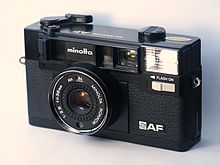- Minolta Hi-Matic
-
Hi-Matic was the name of a long-running series of 35 mm cameras made by Minolta. The original Hi-Matic of 1962 was the first Minolta camera to feature automatic exposure and achieved a small degree of fame when a version (the Ansco Autoset) was taken into space by John Glenn in 1962.[1]
Models
The first Hi-Matic, introduced in 1962, was offered with a 45 mm f/2 or 45 mm f/2.8 lens and featured a built-in selenium light meter and rangefinder. Both the aperture and shutter speed were set automatically. The Hi-Matic was also rebadged as the Ansco Autoset.
The Hi-Matic 7 followed in 1963. It had a faster f/1.8 lens and used a CdS cell instead of a selenium meter. Additionally, it gave photographers the option of setting the exposure manually, an option not available in the original Hi-Matic. The Hi-Matic 7S and Hi-Matic 9, both released in 1966, were slightly improved versions of the popular 7. The 9 was the same as the 7S with the addition of a slightly faster f/1.7 lens. The Hi-Matic 11 of 1969 was a version of the 9 with no manual controls.
In 1969 Minolta came out with a new, smaller model, the Hi-Matic C. In the interest of compactness, it had a smaller 40 mm f/2.7 lens (which was collapsible), reduced aperture and shutter speed ranges, and no longer featured a rangefinder. The C had shutter-priority automatic exposure with a CdS meter. The Hi-Matic 5, also released in 1969, was basically a less expensive C without the collapsing lens.
The Hi-Matic E of 1971 was a much-improved version of the C with a 40 mm f/1.7 lens and a rangefinder. It used the same Electro Control automatic exposure system found on the Yashica Electro cameras. The E was followed by a succession of increasingly inexpensive models, the Hi-Matic F in 1972, the Hi-Matic G in 1974, and the Hi-Matic G2 in 1982. The Electro Control system was abandoned after the F in favor of a simpler system.
The next Hi-Matic model, which was called the Hi-Matic 7 SII and came out in 1977, was considered to be one of the finest Minolta rangefinders. It featured a 40 mm f/1.7 lens and shutter priority automatic exposure in addition to manual controls, all in a compact package.
A built in electronic flash came to the series for the first time in 1978 with the Hi-Matic S. It was a fully automatic (except for focusing) camera equipped with a Rokkor 38 mm f/2.7 lens. There were several variants, including the Hi-Matic SD (date back), the Hi-Matic S2 (slightly slower lens), and the Hi-Matic SD2 (S2 with a date back). Focusing was automated in 1979 with the introduction of the Hi-Matic AF, which was essentially an S2 with the addition of autofocus.
The last Hi-Matic was the Hi-Matic GF of 1984, a very simple and cheap plastic model which was not sold in the United States. It had a 38mm f/4 lens that allowed to choose between three predefined apertures denoted by beginner friendly icons: sunny, partly cloudy and cloudy. Focusing was manual and set in four steps from about 1 m to infinite.
References
- ^ "Astronaut Still Photography During Apollo: Before Apollo", NASA website
External links
Categories:- Minolta cameras
Wikimedia Foundation. 2010.




